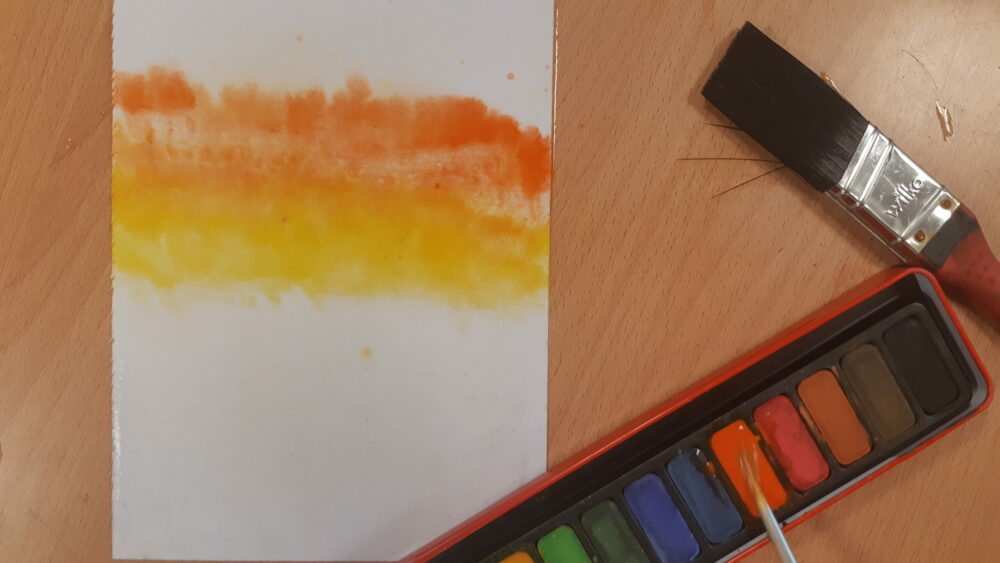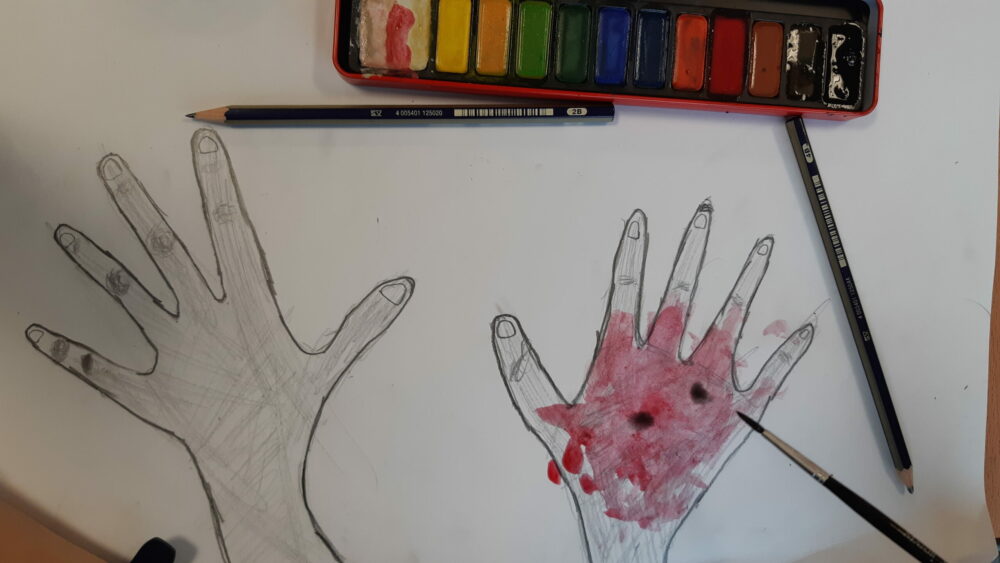Exploring Macbeth Through Art: Out Damn Spot!

In this fifth of six resources on Shakespeare’s Macbeth, we take a closer look at Lady Macbeth’s descent into madness, and specifically her famous ‘Out Damn Spot’ soliloquy.
The aim of the session is to use watercolour to create an observational painting of two hands covered in blood, with the option of adding either an imagined or a representational background. We recommend leaving the finer details and approach open for the children to interpret.
Back to all six sessions here.
Session 5: Out Damn Spot!
Warm Up: 15 minutes
Main Activity: 45 minutes
Materials Needed: Sketchbooks, pencils, charcoal, A4 and A3 watercolour paper (or thick cartridge if watercolour paper not available), watercolour paints, soft round headed brushes, small sponges.
Focus Theme: Health, Order and Disorder
Time to Warm Up! Exploring watercolour paints and the ‘wet on wet’ technique.
Take a sheet of A4 watercolour paper and using a wet sponge or very large brush, smooth water all over the surface of the paper.
Vary the amount of water you add – keeping some areas more wet than others.
Then, using a smaller soft brush, drop some water colour paint onto the paper and watch what happens. Add more paint to other areas before adding more colours. Watch how the colours bleed into one another.


Do any patterns form, or can you see any ‘pictures’? Watercolour paint is different to some other paints in that we can blur, erase or alter existing painting by saturating it with water.


You can see this technique (within a different context) in action here:
Starter Discussion:
After Macbeth has murdered Duncan he is shaken and panicked. He has blood all over his hands and is horrified at the sight of them.
Lady Macbeth has little patience with him and accuses him of being a foolish coward. In response to Macbeth’s anguish, she tells him to ‘Consider it not so deeply’.
She tells Macbeth to wash the blood off his hands and later mentions that ‘A little water clears us of this deed’..’
Macbeth’s feelings are a bit different to this:
‘How is’t with me, when every noise appals me?
What hands are here? Ha! They pluck out
mine eyes!
Will all great Neptune’s ocean wash this blood
Clean from my hand? No; this my hand will rather
The multitudinous seas incarnadine,
Making the green one red’.
What do you think Macbeth is thinking here?
Macbeth is wondering if even the whole ocean will be enough to wash his hands clean of the blood that covers them. The word ‘incarnation’ refers to the carnation flower which are sometimes red. Macbeth is saying that instead of the sea washing his hands clean, his hands will stain the sea red because there is so much blood on them.
Context:
The image of water is used by Shakespeare here to symbolise the washing away of guilt and sin. Later in the play, and despite her earlier calmness, Lady Macbeth is driven mad by guilt and continuously washes her hands to rid them of an imagined ‘spot’ she can’t get rid of.
Shakespeare’s audience would have seen water as life giving as well as cleansing and of course, water is associated with the washing away of sin in Christian beliefs. Shakespeare’s audience would have been followers of the Christian faith, believing in good and evil and that committing sin win went against God’s will.
Main Activity: Lady Macbeth’s Hands
We’re going to explore watercolour in a little more detail.
Take a piece of A3 water colour paper and position it in landscape orientation. Hold your non dominant hand out in front of you and, using the careful looking you’ve used in previous activities, draw a pencil outline of your hand on one side of the paper.
If your non dominant hand is your left, draw your left hand on the left-hand side of the paper and vice versa for the right.
Of course, an easier way to do this is to actually draw round your hand – but drawing by looking develops our skills in observation and careful looking.
Flip your hand over and draw it again, next to the other so that the thumbs are facing. You should end up with a left and right hand (albeit one which is palm facing).


Begin to add some colour and tonal value to your hands. This means looking at the areas of dark and light.
Use some water-soluble charcoal, watercolour pencils or more watercolour paints to add in some detail. Look at your own hands to support this. This will be slightly easier with your non dominant hand as you won’t have to swap between drawing and looking as with your dominant hand – but try not to let that impinge too much and just embrace the challenge!
When you are happy with how your hands look, take some red water colour paint and dab some onto the hands. This represents the blood on Lady Macbeth’s hands that she can’t get off.
You could work back into the hands using pencils or charcoal to further define the form or add tonal value.
Let this dry for a few minutes or so while you move onto the background.
Many of the scenes between Macbeth and Lady Macbeth take place within their castle in Scotland. The scenes between them are at night, hushed and secretive as they plot their murderous deeds. How can you communicate the ‘feel’ of the dark castle walls behind your (Lady Macbeth’s) hands? Think about the materials you have used so far on these sessions. Make choices as to what you think would work best.
Do you want to create some brick like patterns that look like the cold dark stone of the castle walls, or will you go for a more abstract approach – thinking about mood instead? Think back to your heathland pictures that showed the disordered landscape of Macbeth. Can you apply a similar approach to this picture?
When you’re happy with the background, turn your focus back to the hands which should now be dry. Just like Lady Macbeth, you’re going to try and wash off the blood!
You may find it helpful to consider the following words uttered by Lady Macbeth in her madness:
‘Out, damned spot! Out, I say –
One; two: why, then ‘tis time to do’t: Hell
is murky! – Fie, my lord, fie! A soldier, and
afeared? What need we fear who knows it,
when none can call our power to account? –
Yet who would have though the old man o
have had so much blood in him?’
(Act V Scene 1)
Add some water to the hands using a small sponge or brush. Work quite carefully so you don’t completely swamp the paper in water!
Begin to loosen the red paint so that is ‘bleeds’ around the hands and into the water.
Don’t worry if the marks you’ve already made on the hands begin to blur or even smudge into the background. This is supposed to be an exploration of Lady Macbeth’s experience where she believes in her madness that her hands are covered in blood, when in fact she is trying to wash away what isn’t actually there.
Once you feel enough water has been added, let your pictures dry for a few moments before laying up some more lines or marks again. Would the hands benefit from some more shadow at this point? Did something interesting happen when some water merged into the background? Can you build on this?
You may like to let your drawings dry completely and come back to them another day if you have run out of time.
Reflection:
Consider the different stages to this activity: the observational drawing of hands, the watercolour painting, thinking about the background and composition – which did you find the most fun? Why?
Are there any materials you found worked well together? Or any that didn’t for you?
Can you think of any ways you could explore other themes in the play Macbeth using water colour?
Move onto session 6 here.








